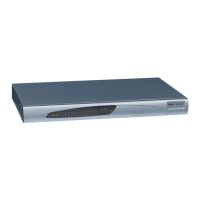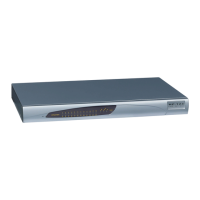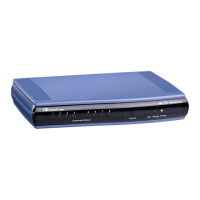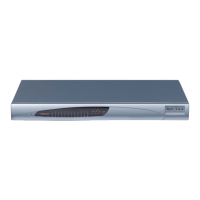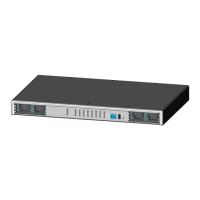MediaPack SIP User’s Manual 5. Configuring the MediaPack
Version 4.6 83 June 2005
5.5.4.2 Tel to IP Routing Table
The Tel to IP Routing Table is used to route incoming Tel calls to IP addresses. This routing table
associates a called / calling telephone number’s prefixes with a destination IP address or with an
FQDN (Fully Qualified Domain Name). When a call is routed through the VoIP gateway (Proxy
isn’t used), the called and calling numbers are compared to the list of prefixes on the IP Routing
Table (up to 50 prefixes can be configured); Calls that match these prefixes are sent to the
corresponding IP address. If the number dialed does not match these prefixes, the call is not
made.
When using a Proxy server, you do not need to configure the Tel to IP Routing Table. However, if
you want to use fallback routing when communication with Proxy servers is lost, or to use the
‘Filter Calls to IP’ and ‘IP Security’ features, or to obtain different SIP URI host names (per called
number) or to assign IP profiles, you need to configure the IP Routing Table.
Note that for the Tel to IP Routing table to take precedence over a Proxy for routing calls, set the
parameter ‘PreferRouteTable’ to 1. The gateway checks the 'Destination IP Address' field in the
'Tel to IP Routing' table for a match with the outgoing call. Only if a match is not found, a Proxy is
used.
Possible uses for Tel to IP Routing can be as follows:
• Can fallback to internal routing table if there is no communication with the Proxy servers.
• Call Restriction – (when Proxy isn’t used), reject all outgoing TelÆIP calls that are
associated with the destination IP address: 0.0.0.0.
• IP Security – When the IP Security feature is enabled (SecureCallFromIP = 1), the VoIP
gateway accepts only those IPÆTel calls with a source IP address identical to one of the IP
addresses entered in the Tel to IP Routing Table.
• Filter Calls to IP – When a Proxy is used, the gateway checks the TelÆIP routing table
before a telephone number is routed to the Proxy. If the number is not allowed (number isn’t
listed or a Call Restriction routing rule was applied), the call is released.
• Always Use Routing Table – When this feature is enabled (AlwaysUseRouteTable = 1), even
if a Proxy server is used, the SIP URI host name in the sent INVITE message is obtained
from this table. Using this feature users are able to assign a different SIP URI host name for
different called and/or calling numbers.
• Assign Profiles to destination address (also when a Proxy is used).
• Alternative Routing – (When Proxy isn’t used) an alternative IP destination for telephone
number prefixes is available. To associate an alternative IP address to called telephone
number prefix, assign it with an additional entry (with a different IP address), or use an
FQDN that resolves to two IP addresses. Call is sent to the alternative destination when one
of the following occurs:
¾ No ping to the initial destination is available, or when poor QoS (delay or packet loss,
calculated according to previous calls) is detected, or when a DNS host name is not
resolved. For detailed information on Alternative Routing, refer to Section 8.7 on page
179.
¾ When a release reason that is defined in the ‘Reasons for Alternative Tel to IP Routing’
table is received. For detailed information on the ‘Reasons for Alternative Routing
Tables’, refer to Section 5.5.4.5 on page 89.
Alternative routing (using this table) is commonly implemented when there is no response to
an INVITE message (after INVITE retransmissions). The gateway then issues an internal
408 ‘No Response’ implicit release reason. If this reason is included in the ‘Reasons for
Alternative Routing’ table, the gateway immediately initiates a call to the redundant
destination using the next matched entry in the ‘Tel to IP Routing’ table. Note that if a domain
name in this table is resolved to two IP addresses, the timeout for INVITE retransmissions
can be reduced by using the parameter ‘Number of RTX Before Hotswap’.

